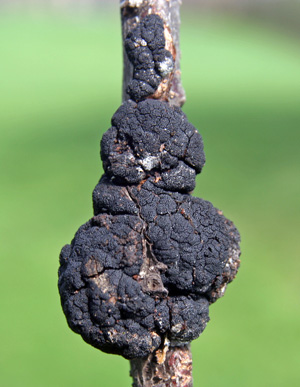By Diana Alfuth, Horticulture Educator

With no leaves to block our view, winter allows us to see trunk and branch structure more clearly. We also sometimes see unusual growths, or galls, on tree trunks and branches. There are a variety of different causes, depending on the tree species.
Galls are formed by excessive and disorganized cell division in response to infection or irritation by bacteria, fungi, or insects or sometimes by environmental stress. In some cases, galls caused by insects are a place for them to lay eggs. Some trees are genetically more susceptible to the formation of galls. Depending on the tree and the cause, galls can remain small, or grow into large burls, prized by woodworkers for the interesting grain pattern.
In some cases, such as the golf-ball sized galls on hickory caused by Phomopsis on hickory (above), the branches can die as the gall encircles the branch. Burls on oaks are often caused by fungi or bacteria, and the trees can live with them for their entire lives. While these galls may lessen the value of timber for lumber purposes, they are mostly a curiosity that we notice more often in winter. If you see swellings or galls on branches of your landscape trees, identifying the cause may be important to determine if pruning them away is recommended.
Many galls can be easily pruned. Check out this information on pruning deciduous trees. Typically you want to use sanitized pruners, and you’ll want to cut about 8 inches down on the branch when removing galls.




